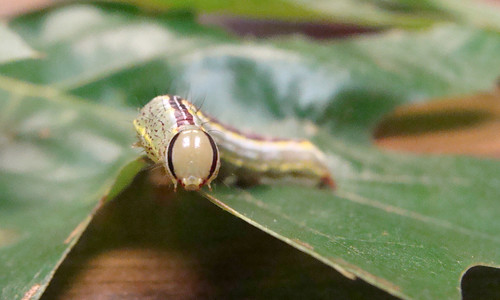The variable oakleaf caterpillar returns: noisy, messy but harmless
By Ryan McGeeney
U of A System Division of Agriculture
Sept. 20, 2017
Fast Facts:
- The caterpillars rapidly feed on oak leaves, but do not harm the tree itself
- Droppings may stain sidewalks, porches and vehicles, but pose no health risk
- The insects overwinter under leaf litter, a good opportunity to reduce population
(412 words)
(Download this story in MS Word here.)
(See more pictures of the variable oakleaf caterpillar in action at https://flic.kr/s/aHsm9f1sUZ.)
LITTLE ROCK – As scourges go, the return of the variable oakleaf caterpillar is pretty mild. But they do have a way of getting your attention.
Cooperative Extension Service agents throughout several southwestern Arkansas counties, including Polk, Pike, Clark and others, began receiving calls earlier this week — concern bordering on panic as large oak trees throughout the region began losing their leaves, practically overnight.
“I’ve probably received 40 calls in the last two days,” Garland County agricultural agent Allen Bates said Wednesday. “The caterpillars are infesting a lot of oak trees, here in Hot Springs — the county courthouse called me up there this morning.”
The variable oak leaf caterpillar — so called because its color can vary widely from one insect to the next — is now embarked on its annual feeding frenzy throughout much of the Southern Plains, gnawing its way through oak leaves, and depositing its droppings on sidewalks, porches and vehicles below. When the caterpillar is in sufficient concentrations, the sound of this process can sometimes be mistaken for rainfall.
But it’s not.
Tamara Walkingstick, Associate Professor of Forest Resources at the University of Arkansas System Division of Agriculture and Associate Center Director of the Arkansas Forest Resources Center, said the caterpillars — a native insect to the region — typically surge when trees are already going dormant for the year, and are an important link in the ecological chain.
“There are a couple of different bird species that rely upon these insects for food, including the pileated woodpecker and blue jays,” Walkingstick said. “So they’re not beneficial to the trees, but they are beneficial to the other predators that utilize these insects. They’re an important food source.”
The caterpillar’s other natural predators include parasites, ground beetles and stinkbugs.
While the caterpillar’s droppings may stain surfaces below, they pose no apparent health risks to humans or pets. Walkingstick said that spraying insecticide on affected trees was both unnecessary and logistically impractical, given the height of many oaks.
“People want to spray things, I know,” Walkingstick said. “But look: it’s going to rain.”
Within a few weeks, the last of the insects will have fallen from the trees to the ground, where they naturally overwinter under the leaf litter, offering concerned citizens a chance to exert a modicum of control.
“It’s a good opportunity to reduce the local insect population by sweeping up the leaves and disposing of them,” Walkingstick said.
To learn about native insects, contact your local Cooperative Extension Service agent or visit www.uaex.uada.edu.
About the Division of Agriculture
The University of Arkansas System Division of Agriculture’s mission is to strengthen agriculture, communities, and families by connecting trusted research to the adoption of best practices. Through the Agricultural Experiment Station and the Cooperative Extension Service, the Division of Agriculture conducts research and extension work within the nation’s historic land grant education system.
The Division of Agriculture is one of 20 entities within the University of Arkansas System. It has offices in all 75 counties in Arkansas and faculty on five system campuses.
Pursuant to 7 CFR § 15.3, the University of Arkansas System Division of Agriculture offers all its Extension and Research programs and services (including employment) without regard to race, color, sex, national origin, religion, age, disability, marital or veteran status, genetic information, sexual preference, pregnancy or any other legally protected status, and is an equal opportunity institution.
# # #
Media Contact: Mary Hightower
Dir. of Communication Services
U of A System Division of Agriculture
Cooperative Extension Service
(501) 671-2126
mhightower@uada.edu
Related Links
